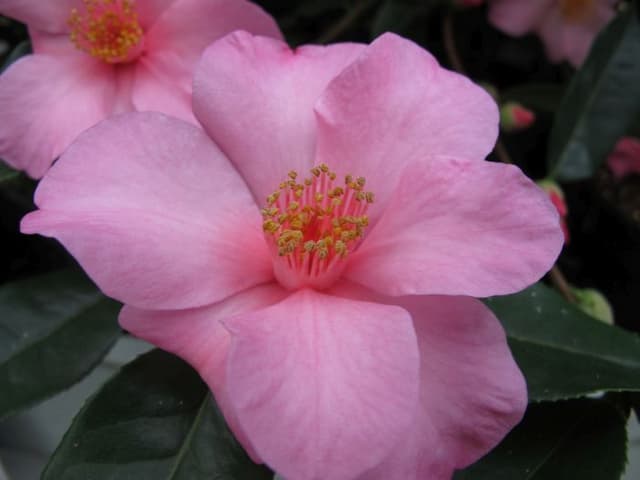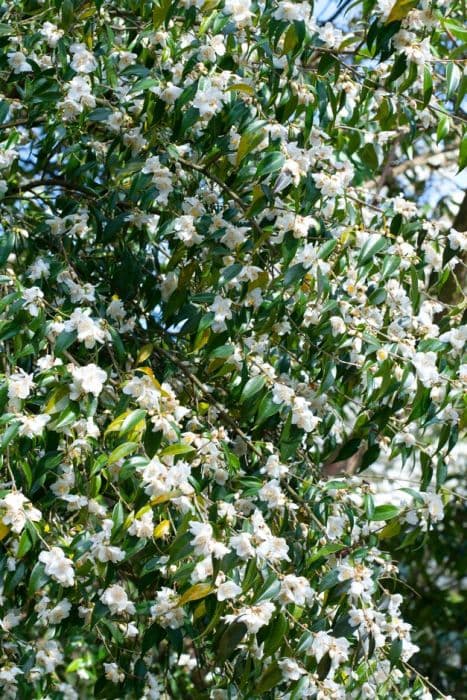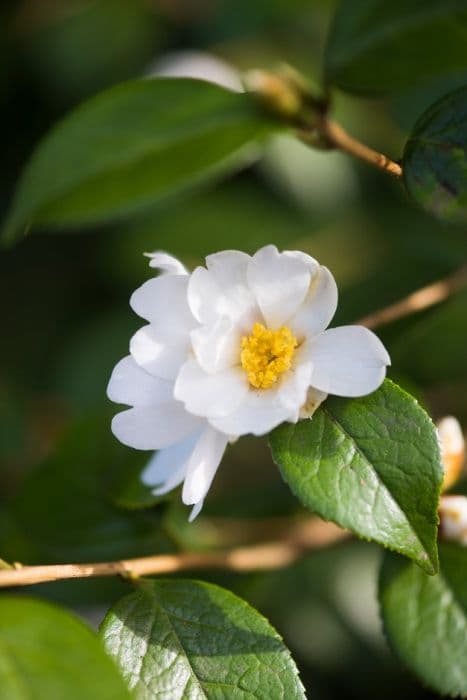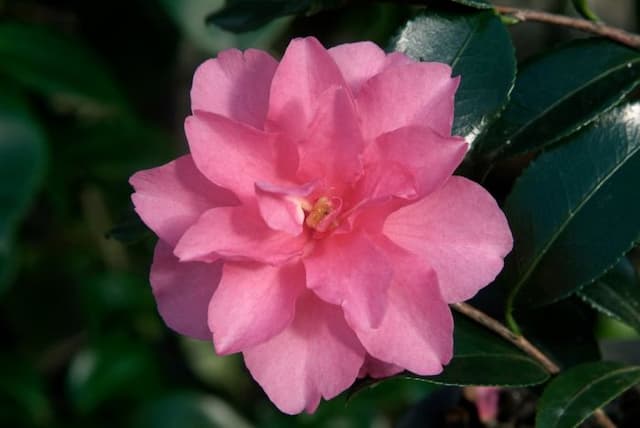Williamsii Camellia Camellia × williamsii 'Mirage'

ABOUT
Camellia 'Mirage' is an attractive evergreen shrub that boasts an elegant display of large, semi-double to peony-form flowers. The blooms are a striking shade of pink, blending beautifully with the glossy, dark green foliage that characterizes the shrub. The petals are elegantly arranged and may show a variety of forms, sometimes presenting with ruffled edges that add to their ornamental value. Between the layers of petals, one may often find a cluster of golden stamens, which bring a pleasing contrast to the flower's color. The leaves of Camellia 'Mirage' are leathery to the touch, with a smooth, shiny surface and a deep green hue that remains throughout the seasons. Their margins are finely serrated, and they taper to a delicate point. Positioned alternately along the stems, the foliage forms a dense, rounded canopy that provides a lush backdrop for the delightful blossoms. This stunning camellia typically flowers in the cooler months, bringing a splash of color to the garden when many other plants are dormant. The blossoms are relatively long-lasting and can provide a visually stunning display over an extended period. As with many camellias, 'Mirage' can be an excellent choice for creating an ornamental hedge or as a feature plant in a mixed border, where its winter-to-spring blooming cycle can be especially appreciated.
About this plant
 Names
NamesFamily
Theaceae
Synonyms
Williamsii Camellia, Hybrid Camellia
Common names
Camellia × williamsii 'Mirage'.
 Toxicity
ToxicityTo humans
The Camellia, which Camellia × williamsii 'Mirage' belongs to, is generally not considered toxic to humans. If ingested in large quantities, it may cause mild digestive upset, but it is not known for causing serious poisoning or severe symptoms. It is always advisable to avoid eating ornamental plants.
To pets
The Camellia is also not considered poisonous to pets, similar to humans. While it is not toxic, ingestion of large amounts of plant material by a pet could potentially lead to mild gastrointestinal upset such as vomiting or diarrhea. As a precaution, it is best to prevent pets from consuming plant parts.
 Characteristics
CharacteristicsLife cycle
Perennials
Foliage type
Evergreen
Color of leaves
Green
Flower color
Pink
Height
6-10 feet (1.8-3 meters)
Spread
5-7 feet (1.5-2.1 meters)
Plant type
Shrub
Hardiness zones
7
Native area
Japan
Benefits
 General Benefits
General Benefits- Ornamental Value: The Camellia 'Mirage' is known for its beautiful flowers which can enhance any garden's aesthetic appeal.
- Long Flowering Period: This variety often has a prolonged flowering season, which can bring color to a garden throughout multiple seasons.
- Tolerant of Shade: Camellias are well-suited for shaded areas where other flowering plants may not thrive.
- Versatile Planting Options: Can be planted in borders, used as a specimen plant, or even grown in containers.
- Evergreen Foliage: Provides year-round greenery and structure to the garden even when not in bloom.
- Low Maintenance: Once established, they require relatively little care, making them suitable for both novice and experienced gardeners.
- Wildlife Attraction: The flowers can attract pollinators like bees, contributing to the ecosystem of the garden.
 Medical Properties
Medical PropertiesThis plant is not used for medical purposes.
 Air-purifying Qualities
Air-purifying QualitiesThis plant is not specifically known for air purifying qualities.
 Other Uses
Other Uses- Camellia 'Mirage' petals can be used for artistic creations such as flower pressing, allowing crafters to preserve their beauty in artworks and decorations.
- The fallen flowers of the Camellia 'Mirage' can be gathered and used to create natural, biodegradable confetti for eco-friendly celebrations.
- Camellia 'Mirage' leaves can be used in compost heaps as a source of organic matter to enrich soil quality in gardens and landscapes.
- When dried, the branches of the Camellia 'Mirage' can be used in floral arrangements, providing a sturdy and attractive support for other blooms.
- The dense foliage of Camellia 'Mirage' can be used to create privacy screens or hedges in gardens, offering seclusion with its evergreen leaves.
- Camellia 'Mirage' can be trained to grow on structures as an espalier, showcasing its flowers on walls or fences for ornamental purposes.
- The wood from pruned Camellia 'Mirage' branches can be used for making small wooden items or crafts, exploiting its hardness and fine grain.
- Buds and young leaves of Camellia 'Mirage' can be collected and used for dyeing fabric, giving natural and subtle color variations.
- Camellia 'Mirage' can play a role in educational settings, teaching about plant growth, pruning techniques, and ornamental horticulture to students.
- The flowers of Camellia 'Mirage' can be sprinkled on top of water features, such as ponds or fountains, to create a serene and picturesque floral display.
Interesting Facts
 Feng Shui
Feng ShuiThe Camellia is not used in Feng Shui practice.
 Zodiac Sign Compitability
Zodiac Sign CompitabilityThe Camellia is not used in astrology practice.
 Plant Symbolism
Plant Symbolism- Adoration and Love: Camellias, in general, are often associated with love, affection, and admiration, making them popular gifts for loved ones.
- Perfection and Excellence: Their lush petals and overall beauty symbolize striving for excellence and achieving perfection.
- Longevity and Steadfastness: Camellias are evergreen plants known for their longevity and resilience, often representing long-lasting devotion and an unchanging nature.
- Gratitude: The camellia flower can serve as a token of thanks or gratitude when given to someone as a gesture of appreciation for their kindness or friendship.
- Refinement and Cultivated Beauty: With its stunning blooms, the camellia represents refined beauty and the cultivation of good character. It is often used in contexts that suggest elegance and dignity.
 Water
WaterWilliamsii Camellias, including the 'Mirage' variety, prefer evenly moist soil, especially during the growing season. Ideally, they should be watered once a week, with adjustments made for rainfall and temperature changes. Provide about 1 to 1.5 gallons of water for each watering session, ensuring it penetrates deep into the root zone without leaving the soil waterlogged. During the winter months, reduce watering frequency as the plant requires less moisture. It's critical to avoid overhead watering to prevent flower blight and to water at the base of the plant instead.
 Light
LightWilliamsii Camellias like 'Mirage' thrive in partial shade with shelter from the afternoon sun. The best spot for this camellia is one where it can receive morning sunlight and dappled shade in the afternoon. Too much direct sunlight can lead to leaf scorch, while too little can affect blooming. Camellias are ideal for east-facing locations where they can enjoy gentle morning rays.
 Temperature
TemperatureWilliamsii Camellias such as 'Mirage' prefer cooler temperatures and can typically survive in a range between 20°F and 90°F. However, the ideal growing conditions are between 60°F and 80°F. These camellias require protection from harsh winter winds and should not be exposed to temperatures below 20°F to avoid frost damage.
 Pruning
PruningPrune Williamsii Camellias such as 'Mirage' after they finish blooming, typically in late winter or early spring. Pruning helps to maintain the plant's shape, remove dead or weak growth, and encourage healthy new blooms for the next season. Cut back to just above an outward-facing bud and refrain from drastic pruning unless renovating an old camellia. Prune sparingly, as camellias do not require heavy pruning and are relatively slow to recover from it.
 Cleaning
CleaningAs needed
 Soil
SoilThe Williamsii camellia requires acidic soil with a pH of 5.0 to 6.5. A best soil mix can be made with 1/3 each of pine bark, peat moss, and perlite or coarse sand to ensure good drainage and aeration.
 Repotting
RepottingThe Williamsii camellia should be repotted every 2-3 years to prevent root crowding and replenish nutrient-rich soil, ideally during spring before the growth season begins.
 Humidity & Misting
Humidity & MistingWilliamsii camellia thrives in moderate to high humidity levels, preferably between 50-70%, which mimics its natural humid forest habitat conditions.
 Suitable locations
Suitable locationsIndoor
Place in bright, indirect light with high humidity.
Outdoor
Plant in partial shade, protect from strong winds and afternoon sun.
Hardiness zone
7-9 USDA
 Life cycle
Life cycleThe life cycle of the Camellia × williamsii 'Mirage', commonly known as the Williamsii Camellia, begins with seed germination, which requires a moist and well-drained soil with partial shade. Following germination, the seedling grows into a juvenile plant with increased leaf production and developing root systems. As it matures, it enters a vegetative stage where it grows steadily in size and form, developing lush, glossy, evergreen foliage. The Williamsii Camellia reaches reproductive maturity after several years, typically producing large, showy flowers in shades of pink or red during late winter or early spring. After pollination, often by bees or other insects, the plant produces fruit in the form of dry capsules containing seeds, which then disperse to give rise to new plants. This camellia variety can live for many years, often several decades, with proper care and favorable conditions.
 Propogation
PropogationPropogation time
Spring-Early Summer
The Camellia × williamsii 'Mirage', commonly known as Williamsii Camellia, is often propagated through semi-hardwood cuttings. This method is favored due to its simplicity and effectiveness. The ideal time to take cuttings is in late summer after the plant has finished flowering and the new growth has started to harden. Cuttings should be about 4 to 6 inches (approximately 10 to 15 centimeters) long, with leaves removed from the lower half. The cut end of the cutting can be dipped in rooting hormone to encourage root development. Then, the cuttings are planted in a mix of peat and perlite and kept in a warm, humid environment until roots have developed, which usually takes several months. It's crucial to maintain the soil's moisture without letting it become waterlogged, as too much moisture can lead to rot.









